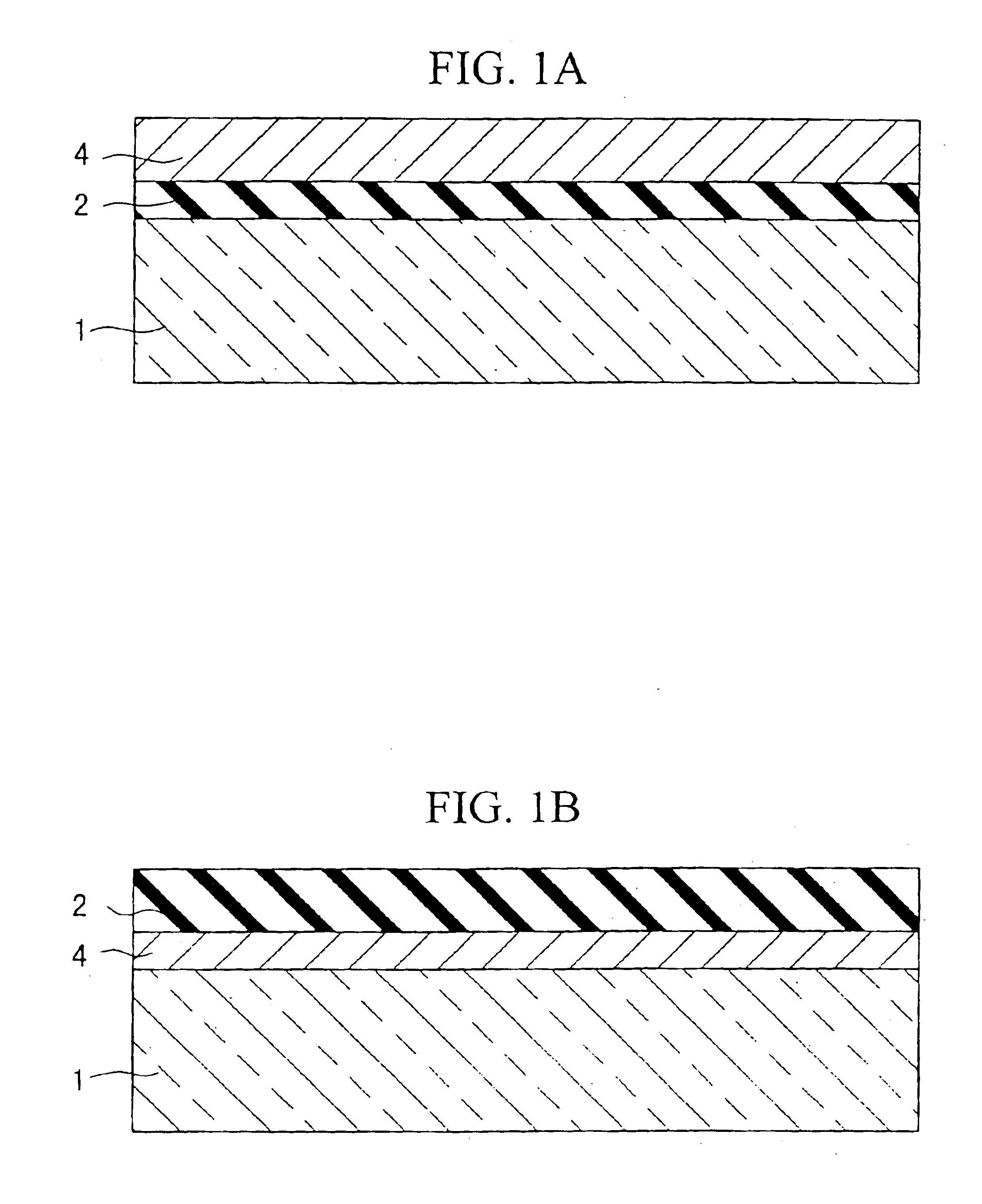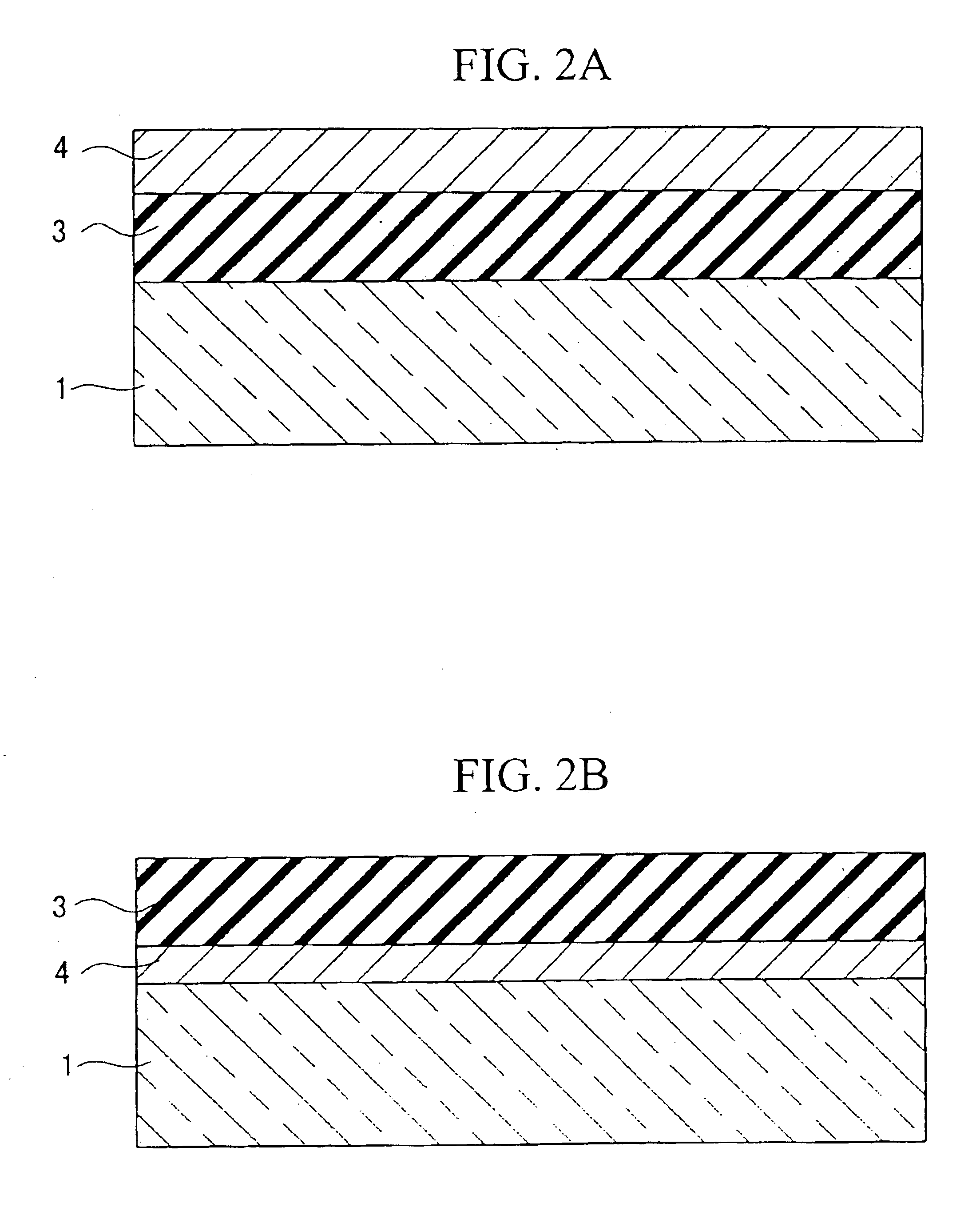Opto-magnetic recording medium with a garnet ferrite recording layer, and opto-magnetic information recording/reproducing device
a technology of opto-magnetic information and recording medium, which is applied in the field of magnetooptical recording medium, can solve the problems of garnet ferrite layer internal stress, thin metal layer prone to deterioration, cracks in garnet ferrite layer,
- Summary
- Abstract
- Description
- Claims
- Application Information
AI Technical Summary
Benefits of technology
Problems solved by technology
Method used
Image
Examples
embodiments 1 and 2
[Embodiments 1 and 2]
FIG. 3 shows two types of section structure of a magneto-optical recording medium having a recording layer which consists of two layers of garnet ferrite / spinel ferrite (or rutile)(hereunder, referred to as "Embodiment 1") or of two layers of garnet ferrite / hematite (hereunder, referred to as "Embodiment 2"). In the case shown in FIG. 3(a), the garnet ferrite layer 3 is layered on the spinel ferrite (or rutile or hematite) layer 2 formed on the quartz glass substrate 1, and the garnet ferrite layer 3 is covered with the metal reflective layer 4. On the other hand, the case shown in FIG. 3(b) is different from the case of FIG. 3(a) in a point that the spinel ferrite(or rutile or hematite) layer 2 and the garnet ferrite layer 3 are layered on the metal reflective layer 4 formed on the quartz glass substrate 1. Incidentally, recording and playback are executed by irradiation of a laser from the bottom and through the quartz glass substrate 1 in the case of FIG. 3(a...
embodiment 3
by the same method used for Embodiments 1 and 2, except that heat treatment for the multiple recording layer 5, which was previously formed by layering a plurality of spinel ferrite (or rutile or hematite) layers and garnet ferrite layers, was performed only once. The layer structure type shown in FIG. 6(a) and that shown in FIG. 6(b) correspond to the case shown in FIG. 3(a) of Embodiment 1 or 2 and the case shown in FIG. 3(b) of Embodiment 1 or 2, respectively.
According to observation of the magnetic properties of Embodiment 3, when either spinel ferrite or rutile, but not garnet ferrite, was selected as the material of the multiple recording layer 5, it had 20000 e of magnet coercive force, 13 emu / cc of saturation magnetization and 10 emu / cc of residual magnetization, and the square ratio was about 0.8, and these values were the same as those of Embodiment 1. Besides, the surface roughness and the crystal particle diameter of the multiple recording layer 5 after heat-treatment we...
embodiment 4
[Embodiment 4]
FIG. 7 shows two types of section structure of a magneto-optical recording medium having a recording layer which consists of two layers of garnet ferrite / spinel ferrite (or rutile or hematite), and grooves for servo control on its surface (hereunder, referred to as "Embodiment 4"). In the case shown in FIG. 7(a), the garnet ferrite layer 3 is layered on the spinel ferrite (or rutile or hematite) layer 2 formed on the quartz glass layer 1, and the garnet ferrite layer 3 is covered with the metal reflective layer 4. On the other hand, the case shown in FIG. 7(b) is different from that of FIG. 7(a) in that the spinel ferrite(or rutile or hematite) layer 2 is layered on the metal reflective layer 4 formed on the quartz glass substrate 1.
As shown in the Figure, in Embodiment 4, the grooves 6 are formed on the surface of the spinel ferrite (or rutile or hematite) layer 2, the garnet ferrite layer 3 and the metal reflective layer 4 by employing a quartz glass substrate 1 havi...
PUM
| Property | Measurement | Unit |
|---|---|---|
| thickness | aaaaa | aaaaa |
| thickness | aaaaa | aaaaa |
| thickness | aaaaa | aaaaa |
Abstract
Description
Claims
Application Information
 Login to View More
Login to View More - R&D
- Intellectual Property
- Life Sciences
- Materials
- Tech Scout
- Unparalleled Data Quality
- Higher Quality Content
- 60% Fewer Hallucinations
Browse by: Latest US Patents, China's latest patents, Technical Efficacy Thesaurus, Application Domain, Technology Topic, Popular Technical Reports.
© 2025 PatSnap. All rights reserved.Legal|Privacy policy|Modern Slavery Act Transparency Statement|Sitemap|About US| Contact US: help@patsnap.com



